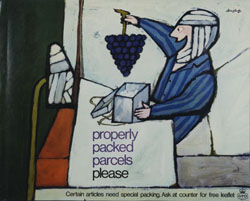Clean as new
Now it’s not often that I get to discover a whole new genre of posters, but today I can share just that with you. Dry cleaning posters.
This whole collection from, I am guessing, the 60s and 70s, was sent to Quad Royal by Roly Seaton. I think the Kenneth Williams-a-like here is one of my favourites.
Roly acquired them when a dry cleaners in Leeds was closing down, and left them outside the shop for any takers. I imagine them having been very dapper in Leeds in the 1960s.
And very well textured. But, quite apart from the kitsch amusement value, I’m interested in these posters for a couple of reasons.
One is that they do, once again, show just how the overall standard of graphics had declined by the 1970s. This poster was clearly done by someone whose day job was illustrating Simplicity patterns.
While all that this one has going for it is the fabulous 1970s image of modernity that it wants you to believe in.
Shagpile, smoked glass, round TV; truly this has to be the future.
Now I wouldn’t claim that any of these posters are design classics, and I don’t suppose I’ll ever know who designed them or when, but they do illustrate once again just how little we know of the visual past. Even after just forty or fifty years, so much of the graphic design that people saw on a daily basis has entirely disappeared. And not just from the dry cleaners. Every greengrocer, every chemist, every corner shop would have been full of posters and signs, hand drawn or printed, good or bad, but almost all of which have gone.
What we think of as the appearance of the 1960s is a very partial construct, made up of London Underground posters, a few high end pieces of graphic or corporate identity design which are now collected and revered, and perhaps a few films. But what most people saw on a daily basis was very, very different – and perhaps as hard to recreate now as the mindset of the Middle Ages. It’s a sobering thought.



















